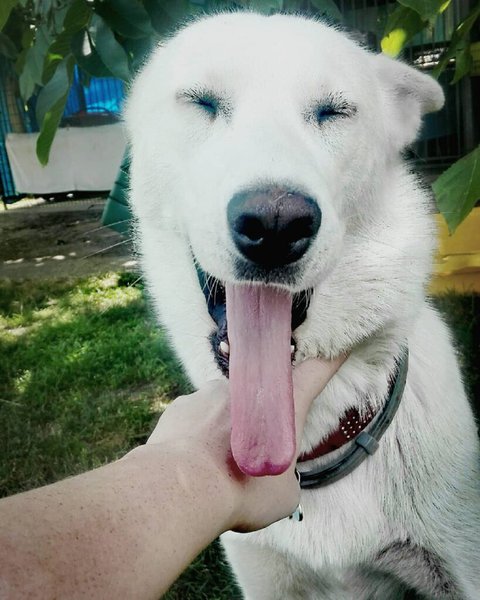Dogs, like humans, have their love languages, and touch ranks high on the list. As a dog lover, you may have noticed several responses from your canine friend when they’re touched. You may wonder if your furry friend responds to a tickle. But can dogs be ticklish?
Yes, dogs are ticklish. Back twitches or sudden ear flicks are signs that a dog feels tickled. However, most dogs enjoy the tickling sensation, and the belly is among their favorite tickle spots.
Knowing your dog’s tickle spots can help improve your bonding through touch. Meanwhile, although most dogs enjoy tickling, you should know what can make your dog unreceptive or react aggressively to tickling. This article reviews common concerns dog lovers have about tickling, signs that dogs are ticklish, and when to avoid tickling a dog. Before that, let’s review the most common places dogs are ticklish.
Where Are Ticklish Spots On A Dog?

Common tickle spots for dogs include bellies, paws, backs, necks, and ears.
Generally, dogs have several tickle spots, and these locations vary by dog. You can find your furry friend’s tickle spot by slowly moving your hands around your pooch’s body and paying attention to places that spur a sudden body movement.
Are Dogs Ticklish On Their Paws?
Yes, some dogs are ticklish on their paws, particularly between their paw pads.
Dog paws may seem tough, but they are sensitive to touch, so they’re a common tickle spot. You may notice some dogs do not love to have their nails cut. This may be because of a tingly sensation they feel when you hold their paws.
Other doggies may draw away once you touch their feet. The high sensitivity of dog paws is also a natural defense mechanism to prevent them from hurting their feet.
Are Dogs Ticklish On Their Belly?
Yes, dogs are ticklish on their belly.
The furless areas of your puppy’s belly and the sides are quite sensitive to stimuli. So, a mild tickling sensation in that region can have a similar effect on them as a belly rub.
Are Dogs Ticklish On Their Ears?
Yes, many dogs are ticklish on their ears.
Dog ears have several nerve endings, making them sensitive to touch. You may notice your canine buddy pulling its ears back when you tickle them there initially.
If your dog enjoys the feeling, there are certain signs that your furry friend wants you to continue. These include moving closer to you, closing its eyes, and gently turning its neck. Some dogs may even fall asleep while you tickle their ears by gently rubbing them.
However, ensure your hands are clean since dog ears are prone to infection.
Where Do Dogs Like To Be Tickled The Most?

Experts believe that each dog has its preferred tickling spot.
However, based on general observations, dogs love to be tickled in the following places:
- Between the paws
- The base of the tail
- Ears
- The underside of its belly
- Its sides
Do Dogs Like It When You Tickle Their Tickle Spot?
Some dogs enjoy being tickled and may nudge you to continue after a first attempt. In contrast, other dogs may instantly show unease at the sensation.
Clear signs your dog does not want to be tickled include growling, tensing muscles, walking away, or snapping at your hand with its teeth.
Meanwhile, a dog that loves tickling will generally take a more relaxed position and may nudge you to continue when you stop. This dog may gently move parts of its body, such as the tail, lick its lips, gently move its feet, and even close its eyes.
What matters is to keep an eye on your dog’s body language to assess if it wants you to continue or are uncomfortable with the sensation.
How Do Dogs Show They Are Ticklish?
Dogs show they are ticklish by responding to touches with involuntary body movements. Movements include ear flicks, back twitches, a slight kicking or parting of the legs, and nose wrinkling.
Some dogs may show these signs for a moment and then be unresponsive. However, these signs may be evident in other dogs the entire time the stimuli persist. Unlike humans, dogs do not become hysterical in response to a tickling sensation.
Are Dogs Ticklish Like Humans?
Yes, dogs are ticklish like humans but respond differently to the sensation.
Dogs and humans possess similar nerve endings on the skin. Therefore, your pup can feel as many sensations from the touch as you. The tickling feeling in dogs differs from gargalesis – the sensation that sends people into fits of laughter.
Tickling can be stimulating, causing dogs to slightly open their mouth, pant faster, and even close their eyes while tilting their head backward.
Do Dogs Laugh When Tickled?

Yes, dogs laugh in their own way when tickled. However, don’t expect a loud sound as in humans.
There are signs that dogs laugh when excited. For instance, dogs’ facial expressions when laughing. According to some studies, the laughing sound produced by dogs sounds like their regular panting sound but with a different rhythm.
While it is difficult for an untrained ear to deduce this laughing sound in a dog, you can tell by a doggie’s happy facial expression.
Scientists also experimented by mimicking and playing these panting sounds to other dogs. They discovered that the sound initiates spontaneous play, increases social behavior, and reduces dogs’ stress.
Is It OK To Tickle My Dog?
Yes, it is alright to tickle your dog if they enjoy the feeling and don’t have health issues that can be made worse by tickling.
If your dog doesn’t love tickling, you shouldn’t tickle them. Also, try not to overdo the tickles, even if your dog enjoys tickling. Like humans, the pleasurable sensation can become uncomfortable if sustained for too long.
If you notice your dog is exhausted or stressed, avoid tickling your furry friend at that time. Doing so could make them feel very uncomfortable.
Meanwhile, dogs with issues such as rashes, flea infestations, allergies, and dry skin may be particularly ticklish. Signs of such conditions include if your four-legged friend responds sensitively or negatively to touch or spends time licking or scratching certain areas. In this case, check in with your veterinarian to treat your furry friend.
Does Tickling Hurt Dogs?

Tickling is not hurtful to dogs unless the dog has a medical or psychological condition that makes them overly sensitive.
Dogs with medical issues, such as abdominal pain, an ear infection, a sore paw, or a cracked toenail, may not find tickling pleasurable in any of these areas.
More reasons dogs may feel hurt by tickling are painful skin lesions, inflamed muscles or tendons, or torn ligaments. Watch to see if your dog responds negatively to touch in some areas. That is a clue that something is wrong with your furry friend.
However, some dogs may refuse your tickle or other forms of touch for psychological reasons. First, tickling may bring an expectation of pain. Dogs with a history of abuse from previous owners may show this trait.
Second, poor handling at the puppy stage can make dogs unreceptive to tickling. Dogs unused to touch during early handling may find it discomforting when you tickle them.
Visiting a vet will help to clear or validate your suspicions and do the necessary therapy to get your dog back to optimal physical or mental health.





